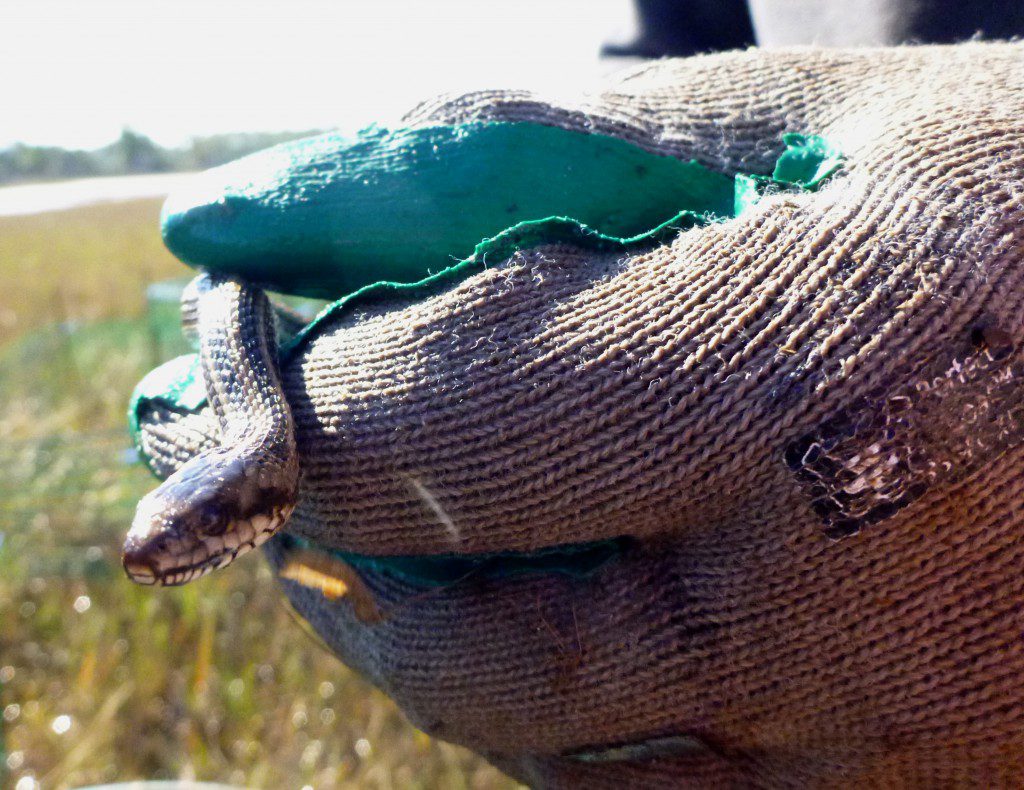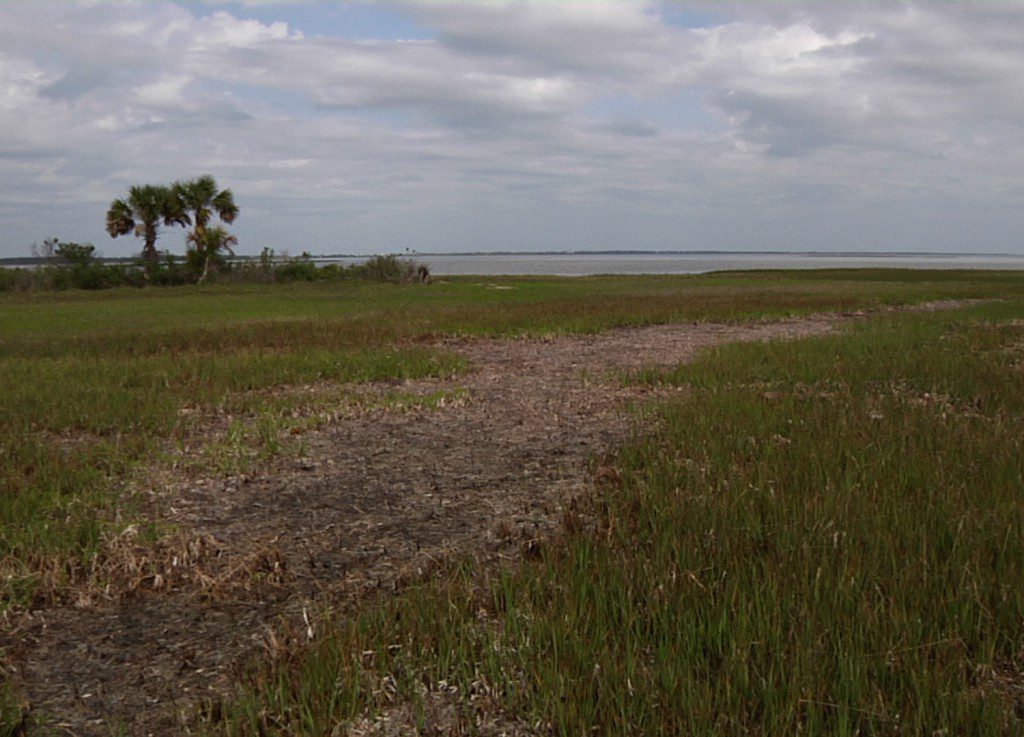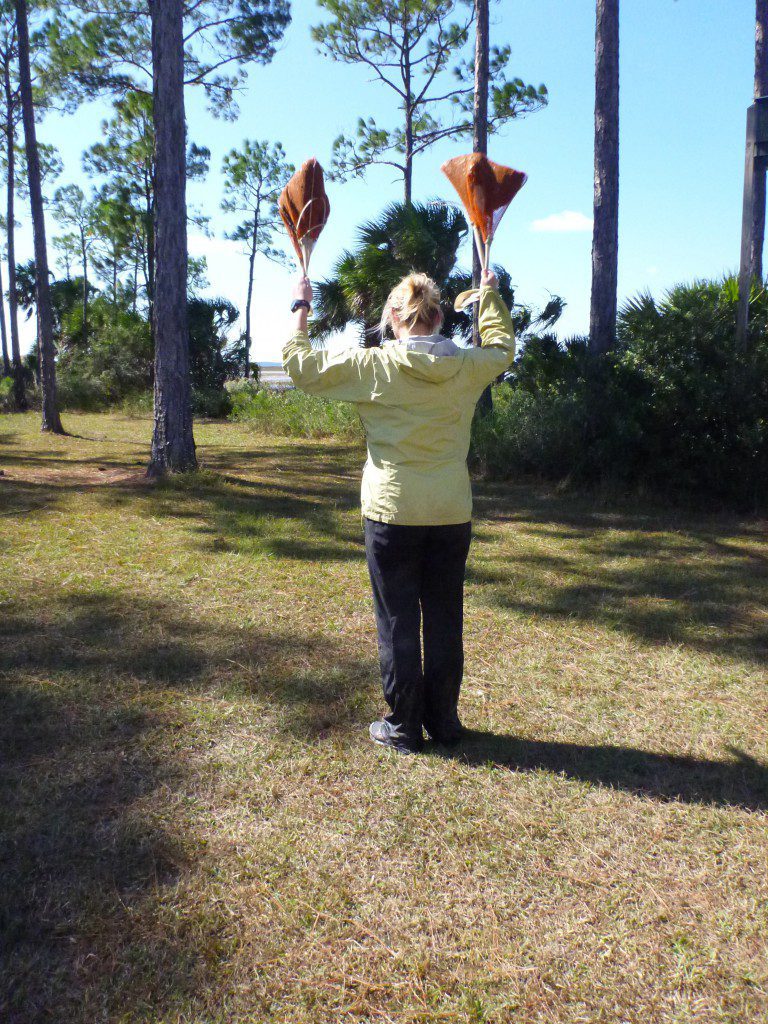2-Minute Video: Seagrass wrack kills part of the marsh, but do its benefits outweigh the destruction?
Our videos to date have centered on biodiversity in the marsh and how it can make a marsh stronger against disturbances. As we see in this video, at least one type of disturbance might actually promote genetic and/ or species diversity.
Dr. Randall Hughes FSU Coastal & Marine Lab/ Northeastern University

This snake was found in a seagrass wrack experiment in the Saint Joseph Bay State Buffer Preserve. Blue crabs were often found taking shelter in their experimental plots as well.
This time of year if you look around salt marshes in our area, you’ll probably see a strip of dead plant material, or “wrack”, resting on top of the salt marsh plants around the high tide line. Look closer, and you’ll see that it’s mostly made up of seagrass leaves that have either been sloughed off naturally (seagrasses produce lots of new leaves in the summer and shed the old ones) or, occasionally, uprooted by boats driving through shallow seagrass beds. Look even closer (say, by picking it up), and you may just find a harmless marsh snake (or worse, a cottonmouth!) – in our experience, they like to hang out in the cool, moist areas under the wrack.
So is this wrack “good” or “bad” for the salt marsh? As with many things in life, the answer depends on your perspective. If you’re a snake or other critter that likes the habitat provided by the wrack, then it’s probably a good thing. On the other hand, if you’re one of my crew who finds that snake, and particularly if you’re Robyn who REALLY doesn’t like snakes, then it’s most definitely a bad thing. Or, if you happen to be the plant that the wrack settles on top of for long periods of time, then it’s a bad thing, because many of those plants die. But, if you’re a seed that is looking for a good spot to germinate in the marsh, then the bare spot created by the wrack is likely a good thing.
 Last fall, David and I teamed up with Dr. Peter Macreadie from the University of Technology Sydney to find out how the bare “halos” created when wrack mats smother the underlying marsh plants influence the marsh sediments. It turns out, these bare areas store less carbon in the sediments than the nearby vegetated areas, which makes them less valuable as “sinks” for carbon dioxide. But as I mentioned earlier, the bare areas can also serve as a good spot for new plant species (or new genotype of a given species) to start growing, potentially increasing the overall diversity of the salt marsh. And as the seagrass wrack decays, it can provide valuable nutrients to the marsh sediments that support future plant growth. So what is the net outcome of all these good and bad effects?
Last fall, David and I teamed up with Dr. Peter Macreadie from the University of Technology Sydney to find out how the bare “halos” created when wrack mats smother the underlying marsh plants influence the marsh sediments. It turns out, these bare areas store less carbon in the sediments than the nearby vegetated areas, which makes them less valuable as “sinks” for carbon dioxide. But as I mentioned earlier, the bare areas can also serve as a good spot for new plant species (or new genotype of a given species) to start growing, potentially increasing the overall diversity of the salt marsh. And as the seagrass wrack decays, it can provide valuable nutrients to the marsh sediments that support future plant growth. So what is the net outcome of all these good and bad effects?
We decided to do an experiment to answer that very question. As Ryan and Meagan will attest (along with almost everyone else in our labs who we enlisted to help us), this was a very labor-intensive experiment. First, we had to figure out how much wrack is typically in a given area of marsh. Then, we had to collect a lot of wrack, weigh it, assemble it into bags that could be “easily” moved to our experiment, and add it to cages that would help hold it in place. We’re talking ~1.5 tons of wrack picked up and moved to various spots!
 To make matters even more interesting, we had to soak the collected wrack in water to make sure it was all the same wetness, and then spin it around in mesh bags (think salad spinner on a very large scale) for a set amount of time to make sure we could get a consistent weight measurement on each bag. Anyone driving past the SJB Buffer Preserve in early September of last year must have wondered what craziness we were up to! And since we were interested in whether the length of time the wrack sits in one place influences its effects, or whether the number of times that wrack sits in a particular area matters, we moved all of this wrack around in our cages every 2 weeks for 3 months to mimic the movement of natural wrack by the tides. And then we measured everything we could think of to measure about the marsh.
To make matters even more interesting, we had to soak the collected wrack in water to make sure it was all the same wetness, and then spin it around in mesh bags (think salad spinner on a very large scale) for a set amount of time to make sure we could get a consistent weight measurement on each bag. Anyone driving past the SJB Buffer Preserve in early September of last year must have wondered what craziness we were up to! And since we were interested in whether the length of time the wrack sits in one place influences its effects, or whether the number of times that wrack sits in a particular area matters, we moved all of this wrack around in our cages every 2 weeks for 3 months to mimic the movement of natural wrack by the tides. And then we measured everything we could think of to measure about the marsh.
We’re still going through all the data to determine the net outcome, but as expected, whether the wrack is a blessing or curse depends on who you are:
- Juvenile blue crabs seem to like hanging out in the wrack (which is a much nicer surprise to find than a snake, even when they are feisty!)
- Fiddler crabs also appear to like the wrack, with greater burrow numbers when wrack is present.
- Contrary to our expectation that wrack would kill cordgrass and allow other plant species to recruit into the marsh, it looked like cordgrass actually did better in the wrack cages!
- Sea lavender, a marsh plant with very pretty purple flowers, does not do so well when covered with wrack (Learn more about sea lavender and its relationship with mussels).
More to come once all the data are analyzed…
This material is based upon work supported by the National Science Foundation under Grant Number 1161194. Any opinions, findings, and conclusions or recommendations expressed in this material are those of the author(s) and do not necessarily reflect the views of the National Science Foundation.
Music in the piece by Philippe Mangold.
